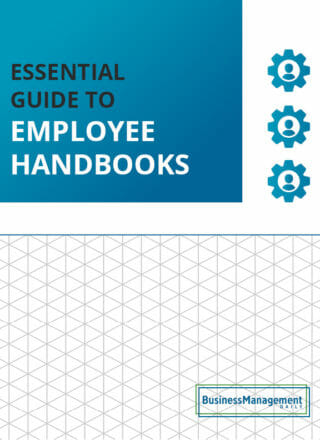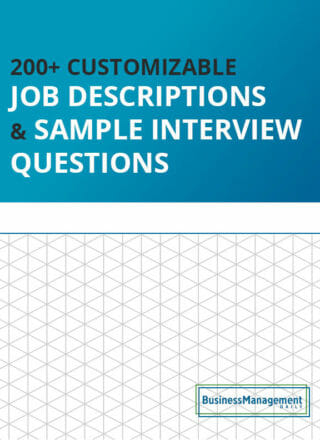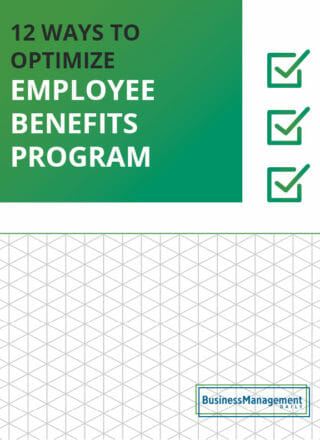Annual performance review template
Standardize your performance reviews for maximum impact
Performance review time is often something that both employees and managers dread. Reviews can be awkward, contentious, or usually feel like a waste of time. Sometimes, that’s true. However, performance reviews can also be incredibly valuable tools.
They create opportunities for employees to get feedback on their job performance, what’s working well, and what needs improvement. They even give employees a chance to provide their input.
However, performance reviews are less valuable as organizational tools if they are done differently year after year or even in the same year by different managers. Consistency is critical to an effective performance review—it’s how you compare employee performance and measure improvement.
That’s why it’s vital that you use a consistent format, process, and performance review template. A template ensures that each manager reviews each employee in the same way year after year.
So what should be included in a performance review template? Let’s take a look.
Types of annual performance review templates
Many performance review templates are available based on what you’re looking to get out of them. Different approaches may work better for your team, depending on your workplace culture. Or you may find that a combination of approaches works best.
Here are a few of the most common options.
General performance review template
This performance review template assesses an employee’s overall performance. It combines a quantitative scale with qualitative questions to provide additional context for the qualitative data.
This mixed structure usually works well for employers, as it includes easily comparable numbers. However, it also allows you to expand upon different points and add nuance.
Narrative structure performance review template
The narrative structure is similar to the general performance review template in that qualitative questions exist. However, you only rate employees using long-form answers, and there’s no quantitative scale included.
For larger organizations, this may not work well on its own. Many companies use performance reviews to determine raises, promotions, and such. In that case, you’ll want some hard numbers to compare employees easily.
Quantitative scale performance review template
This performance review template only has quantitative questions, so no open-ended questions exist. Since you can’t expand upon any of your questions, you have limits in communicating information. A benefit is that it’s typically faster to complete and more accessible to cover many performance areas simultaneously.
This may work well on the back end of an employee management system. However, when meeting with employees, be sure to give additional information. For them to improve, they’ll need more insight from you than just a 3/5 on a review.
Self-assessment performance review template
The self-appraisal performance review allows employees to rate their own performance. This is useful because you can understand how they think they’re doing and compare that to how you view their performance.
Holding reviews in this way allows for a more comprehensive understanding of employee performance instead of solely being a one-sided experience.
Companies often have employees self-evaluate while their supervisor reviews them independently. The two then meet and discuss the differences between their reviews. This can provide valuable insight and give employees a structured opportunity for input.
360 performance review
A 360-degree performance review involves the supervisor reviewing an employee and their coworkers. Coworkers who frequently interact with the employee will provide input on their interactions, the employee’s timeliness, the quality of the work, etc.
This gives additional insight that a supervisor might not see daily and creates a more complete picture of the employee’s performance.
The downside, however, is that such a review is much more labor-intensive than the normal process. You’ll often want several employees to provide input. Thus, this is only sometimes a pragmatic approach for each employee and is often reserved for key performers or employees who may be upcoming leaders.
30-60-90 performance review template
A 30-6-90 performance review is most often used for new employees, assessing their performance at key points during onboarding. It will determine how well a new employee adjusts, learns job responsibilities, etc…
This is not often used after the new hire onboarding process. However, it could be valuable if an employee is on a performance improvement plan or is adjusting to a new promotion.

How to prepare to complete a performance review
Having a performance review template will help you be more organized and strategic in your performance evaluation process, but that’s not the only thing you must prepare.
You should complete some additional things before starting the performance review process to allow for the best results.
- Gather all relevant performance review criteria, employee goals, and prior goal progress information.
- Gather all relevant employee data and examples related to performance.
- Create an agenda for the meeting and prepare notes.
- Schedule the performance review meeting.
- Set expectations for the meeting.
Performance review template components
We’ve included the following sections in our sample performance review template. However, it’s important to note that no performance review form will perfectly match an organization’s needs. As such, it’s important to adapt templates to suit your own needs.
We’ve worked in some places where you can add your own traits and skills to assess. In addition, each section here can be removed or added to easily. You can remove those sections from this template if you track employee goals elsewhere.
Employee information
While this may seem obvious, ensuring that all critical identifying information is included in the performance review is essential. For a small business, the employee’s name may be adequate.
However, in larger organizations, you may add the employee’s ID, office location, and other information to help with organization and identification.
Likewise, include appropriate information on the reviewer. Sometimes, an employee’s supervisor might change during their employment. Knowing who performed the review is helpful when reviewing old performance review records.
This data can also be beneficial when comparing performance reviews across the organization. For example, Human Resources may notice that one manager tends to review their staff more critically than another.
Core traits
In this section, you’ll assess an employee’s most important traits and qualities. These include work quality, communication skills, decision-making, and more. In addition to including some general recommendations for traits to assess, we also left space for you to add a few of your own.
These may be done organizationally, across the department, or vary based on the skills needed for an individual position.
Regardless of your choice, these traits should be similar yearly or across different organization sections. Performance reviews measure performance over time, growth, and improvement. As such, it’s important to ensure that the goals and benchmarks stay fairly consistent.
We’ve chosen a rating scale of 1 to 5 for simplicity. However, you may opt for a different scale that removes numbers altogether or use a more simplified ranking system, like evaluating employees on a scale of 1 to 3.
Performance goal assessment
Many employers like to set goals for employees throughout the year. These may include taking on new types of projects, taking a leadership role in a particular group, advancing certain skills, and more.
Whether you’re assessing an employee mid-year or doing an annual evaluation, it’s important to check back on these goals. Is the employee making progress? Did they complete the goal? Did something change throughout the year, and is the original goal no longer relevant?
Be sure to spend some time determining if the goals have been achieved satisfactorily and, if not, what factors contributed to that. The original goal may have been unrealistic.
Or, it may have been impossible to complete. In these cases, you should not hold it against the employee. Therefore, be sure to note this in the comments section.
New performance goals
Here, you can set new goals for the upcoming period or adjust existing goals as things change during the year. Be sure to set measurable targets and benchmarks throughout the year that will monitor an employee’s growth and development.
A goal shouldn’t be set in January and then not reviewed until December. Instead, it should be followed and reviewed throughout the year.
Overall employee rating
Not everyone might feel comfortable boiling down an employee’s full year of work to a one-digit number. However, in large organizations, simple points of comparison are often needed to compare employees.
Thus, it may be necessary to do so. Be sure to determine if your organization will only use whole numbers like 3 and 4 or if giving an employee a 3.5 is okay.
While you may decide to simply add up and average all an employee’s ratings from the traits assessment to come up with a number, don’t forget to factor in their movement on their goals.
Additionally, if new projects came up during the year and the employee stepped up, be sure to include that as well and provide comments.
For example, if you originally planned to give an employee a 3, but they took on a new project mid-year and did a stellar job. Still, it was outside the scope of their original goals, so you might consider giving them a 4 instead. Just be sure to include your reasoning in the comments section.
Employee comments
Performance reviews are not always pleasant experiences for all parties involved. After all, employees who need improvement may be upset about the results and disagree with the reviewer. As such, leaving space for an employee to provide feedback on the review can be a good idea.
It’s important not to let this section become a 2-page rant about the employee’s dissatisfaction with the company. It should be kept simple and direct, focusing on the points assessed in the review.
An employee may be dissatisfied. As a result, they may object to signing a review with which they disagree. However, they are more likely to accept the review if they can voice their disagreement.
Acknowledgments
Don’t forget this important step. Performance reviews are assessments, organizational tools, and sometimes legal documents. It’s vital that both the employee and the reviewer acknowledge that the review took place.
The employee acknowledges that the assessment was conducted and the results were received. However, signing this section does not indicate that the employee fully agrees with the assessment.
Annual performance review template
Now that we’ve reviewed the key sections, you can download our annual performance review template and customize it to fit your needs.
Sample employee performance review template interview questions
While the base performance review template focuses on assessing performance in a more quantitative way, a performance review is also a chance to get a qualitative feeling for how an employee is doing.
As such, it is essential to ask employees questions to determine their feelings about their work, the job, challenges, and more.
Below are some examples of questions to ask during a performance review. You may opt to add these to the review document and record the answers, or you may simply use them as guidance in steering a conversation.
Previous performance
- What accomplishments are you most proud of?
- What goals did you meet?
- What goals did you fall short of?
- What specific contributions have you made to the team?
- How well do you think your team accomplished its goals this year?
Current job role
- What do you like least about your current role? How would you change it?
- What do you like most about your current role?
Employee strengths & performance improvement areas
- What personal strengths help you do your job well?
- What makes you the best fit for the position?
- What work tasks are most effortless for you?
- What can I do better to help you reach your goals?
- What things will you focus on in the next quarter to help you grow?
- Are these concerns a fair assessment of your performance?
Problem-solving
- Do you have any ideas to improve the current issues?
- Do you believe the outlined solutions will improve your job performance?
Future performance
- What type of career growth is most important to you?
- What are your most important goals for the next quarter?
- What professional growth opportunities would you like to explore?
- Do you feel you can realistically meet your goals?
- How optimistic are you about your team for the upcoming year?
Manager-employee relationship
- What can we do to improve our relationship?
- How do you prefer to receive feedback/recognition for your work?
- Do you feel supported as a whole by your manager and the company?
Additional questions
- Are there any additional noteworthy accomplishments to consider?
- What actions were taken to improve performance from the previous review?
- What are the professional development goals?
- What areas require improvement in job performance?
 Performance review quantitative questions
Performance review quantitative questions
You can incorporate the following questions in your performance review and provide input based on a quantitative scale, such as a rating from 1 to 5.
Depending on your performance review template, these questions might include follow-up narrative responses or stand-alone.
- How productive is the employee?
- What’s the quality of their work in terms of errors, mistakes, and accuracy?
- How consistently does the employee show up to work and arrive on time?
- Does the employee make decisions using sound judgment?
- Can the employee make quality and timely decisions?
- Does the employee create a motivating climate while training and developing team members and take corrective action as necessary?
- Can the employee analyze work, set goals, and develop plans of action to get the job done promptly?
How to improve the performance review process
Performance reviews are integral to employee job performance expectations and communication, so you should consistently seek opportunities to improve the process from beginning to end.
Here are some ways to do that.
- Provide consistent feedback. In addition to offering regular performance reviews, you should regularly provide feedback via check-ins. It has been found that when employees receive more frequent feedback, there are higher levels of employee engagement.
- Build trust. You want to build and maintain trust with your employees to share feedback throughout the year.
- Follow up. After the performance review, make it clear that there will be another one and the time frame they should expect it to happen. Also, provide action items, goals, or focus areas until the next performance review meeting.
- Determine Your Frequency. You want to determine how frequently you should hold your performance appraisal meetings. Perhaps it’s best to keep one covering the entire year, or you’d prefer quarterly performance reviews. Ultimately, you want to choose the frequency that will best help your employees, and the company as a whole better collaborate and secure measurable metrics to improve performance.
Additional resources:
Performance reviews to empower employees and your business ![]()
7 tips for more effective written performance reviews ![]()
12 common mistakes employers make in performance reviews ![]()






